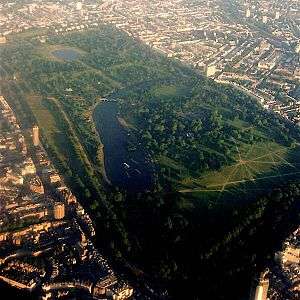Southwark Park
Southwark Park is located in Rotherhithe, in central South East London, and is managed by the London Borough of Southwark. It first opened in 1869 by the Metropolitan Board of Works as one of its first parks. It was designed by Alexander McKenzie and covers 63 acres (250,000 m2).[1] It takes its name from being in what was the old Parliamentary constituency of Southwark at the time of its opening.
It received £2.5 million from the National Lottery's Heritage Lottery Fund in 1998 which enabled large parts of the park to be refurbished.
Facilities

The bandstand dates from 1884 and was originally sited in the Royal Horticultural Society grounds at South Kensington. It has a sister in Peckham Rye Park.
The Old English Cottage Garden was designed by Col. J.J. Sexby, Parks Superintendent for the London County Council. The idea for the rose garden came from Dr Alfred Salter, Member of Parliament for West Bermondsey. It was opened in 1936 and was named after Ada Salter when she died in 1943.[2]
Other facilities include a cafe, a wildlife garden, a boating lake and an art gallery. Sports facilities include an athletics track run by Fusion, a bowling green, football pitches, a cricket pitch and tennis courts.
There are "Friends of Southwark Park" and "Young Friends of Southwark Park" groups to encourage the community to get involved in the management of their park. The Friends of Southwark Park is a non-party-political community organisation, recognised by the London Borough of Southwark. Its primary role is to liaise with, and encourage the Council to look after the parks in the interests of the people who use them.[3]
Trees
As with many spaces within London, the Plane tree (Platanus x hispanica) is dominant within Southwark park particularly the northern most section around the bandstand, which runs next to Jamaica Road.
However, the park is also rich in trees less common in London. Opposite the entrance to the art gallery is a Walnut tree (Juglans regia) and a series of three or four Silver Maples (Acer saccharinum). There is as also a Red Oak (Quercus rubra) close to these maples. Next to the duck pond and the garden area there are three Swamp Cypresses (Taxodium distichum), although without the distinctive wooden 'knees' which sometimes surround trees of this variety.
Transport
There are three London Overground stations (formerly on the London Underground network's East London Line) and two London Underground stations (One sharing with the London Overground) located near the edges of Southwark Park. In clockwise order starting from the west, they are:
- Bermondsey (Jubilee line)
- Rotherhithe (London Overground)
- Canada Water (London Overground and Jubilee line)
- Surrey Quays (London Overground)
Local buses 47, 188, 381, C10 and P12 buses serve the park at the Jamaica Road entrance. At night the park is served by N199 and N381 buses, while the 47 and 188 buses runs a 24-hour service.
The P12 also serves the park as it travels along Southwark Park Road and stops near the entrance there.
Local buses 1, 199 and N1 buses stop nearby the park along Lower Road, at Surrey Quays Station, near the Lower Road entrance and at Rotherhithe Police Station, which is across from Gomm Road, where another entrance to the park is at the end of it.
The 1 and 381 buses, along with their night routes; N1 and N381 also stop at Warndon Street, on Rotherhithe New Road, this is the closest stop to the Hawkstone Road entrance.
Image gallery
- Autumn Leaves
- Wildlife
- Wildlife
- Evening
References
- ↑ Archived December 31, 2006, at the Wayback Machine.
- ↑ Archived March 12, 2007, at the Wayback Machine.
- ↑ "Friends of Southwark Park". Friends of Southwark Park. Retrieved 2014-05-20.
External links
- Southwark Park
- Website of The Friends of Southwark Park
- Cafe Gallery web site
- Southwark Park athletics stadium
- Southwark Park Cricket Club
Coordinates: 51°29′42″N 0°03′22″W / 51.495°N 0.056°W
